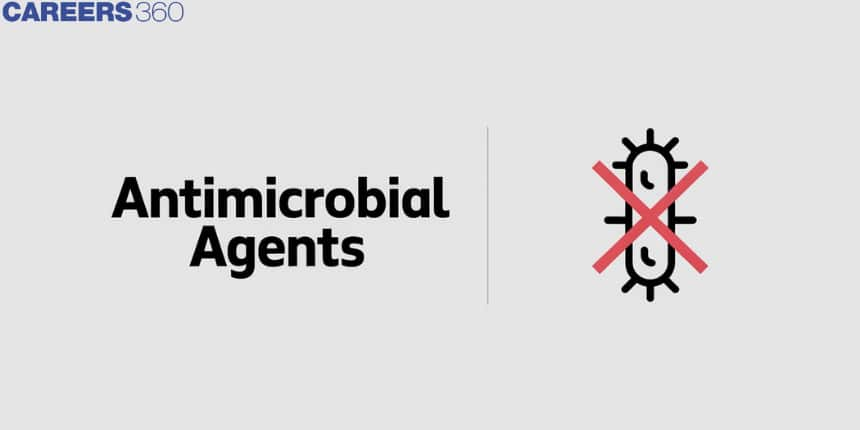Antimicrobial Agents: Definition, Types, Side Effects, FAQs
The term antimicrobial arises from the Greek words which simply mean anti (against), micro (little) and bios (life). It is defined as all agents that function very well against microbial organisms. Antimicrobial agents include many different agents such as antibiotics, antibacterials, antifungals, antivirals and antiprotozoals. Antimicrobial agents are classified as drugs and chemical substances that play a very important role by acting in two modes. These antimicrobial agents can kill and eat (microbicidal) or slow the growth of microbes (microbiostatic). Antimicrobial medicines are also available in the market and they are generally categorized on the basis of the microorganisms they act primarily against. For instance, antibacterials play a very important role against bacteria. In a similar way, antifungals are used against fungi.
This Story also Contains
- Antibiotic Definition
- Different Types Of Antibiotics:
- Side Effects Of Antibiotics
- Antifungal Agents
- Types Of Antifungal Drugs
- Antiprotozoal Agents

Antibiotic Definition
Antibiotics are defined as the chemical compounds that are responsible to kill or stop the growth of bacteria. Truly speaking, antibiotics are defined as a further class of organic anti-infective agents that are usually produced from bacteria or moulds that are toxic to many other bacteria and can kill them. But, the term antibiotic is now used in an easy way that comprises anti-infectives produced from synthetic and semisynthetic compounds.
Different Types Of Antibiotics:
Penicillins
Antibiotics of this class are also known as the "beta-lactam" antibiotics, because of their structural formula. The penicillin class comprises five groups of antibiotics that are named as :
aminopenicillins, antipseudomonal penicillins, beta-lactamase inhibitors, natural penicillins and, the penicillinase resistant penicillins
Tetracyclines
Tetracyclines are defined as broad-spectrum antibiotics that are effective against many bacteria. These are used to treat conditions such as acne and urinary tract infections (UTIs). These antibiotics are also effective against intestinal tract infections and also against eye infections. These antibiotics also treats sexually transmitted diseases, periodontitis (gum disease), and other bacterial infections.
Cephalosporins
Cephalosporins comprise a total of the five generations. These antibiotics have expanded coverage towards the class that include gram-negative infections. Newer generations of cephalosporins that are now available with updated structures are developed to function for wider coverage of certain bacteria. Cephalosporins are bactericidal; that means they can kill bacteria and work in a way similar to the way penicillins work.
Side Effects Of Antibiotics
There are many different types of antibiotics which includes :
diarrhea
nausea
vomiting
rash
upset stomach
sensitivity to sunlight, when taking tetracyclines
Low platelet count can also be seen when the cephalosporins, and penicillins are taken.
Sometimes aches and pains may occur when taking fluoroquinolones
There can be hearing loss, when consuming macrolides or aminoglycosides
low granulocyte defined as a type of low WBC — count, when consuming penicillin can also be observed
Formation of kidney stones can be also observed when taking sulfonamides.
Antifungal Agents
These are defined as antimicrobial agents that can include a drug or chemical that aluminates the fungal pathogen from the host where it is causing the disease. The fungal agents can be seen on the skin and nails of the human being so to eliminate these kinds of fungal infections antifungal agents are used. Fungi was defined as a eukaryotic organism that causes certain infections and can also lead to the death of human being.
Antifungal agents are classified according to the mode of action they caused which is by the
cell wall synthesis
Integrity with the plasma membrane
Synthesis of the nucleic acid
Functions ribosomal unit
Types Of Antifungal Drugs
There are many different antifungal drugs which are :
Systemic antifungal drugs
These drugs include antibiotics such as amphotericin B.
These can also include some of the derivatives of the azole such as the images Imidazole and triazole.
Topical antifungal drug :
These include some of the polyene antibiotics such as the hemisin
These also include some of the hetero cyclic bezofurans such as the griseofulvin
Antiprotozoal Agents
These are defined as the class of the drugs that are used to treat the diseases and infections that are caused by the protozoan agents. These are the Single Cell organisms that belong to the group and Kingdom of the parasite protozoans. These agents cannot be seen by the naked eye and they have a clearly defined nucleus when visible under the electroscope. Antiprotozoal agents are affected in treating some of the diseases such as the sleeping sickness disease and also the inflammatory infection that is caused by the trypanosoma.
Frequently Asked Questions (FAQs)
There are two different types of antimicrobial therapies that are available:
Microbicidal therapy – It is responsible for killing microorganisms.
Microbiostatic therapy – It is only used to prevent microorganism growth and do not kill microorganisms.
There are usually two different types of penicillin
Penicillin VK – It is responsible to fight against bacterial infections. Examples include Ear infection.
Penicillin G – They are seen to be effective against gram-positive and gram-negative cocci bacterial infections. Examples of this include susceptible bacterial infections in the stomach.
Immunosuppressants are defined as any agent in a class of drugs that are responsible for inhibiting the immune system. Immunosuppressants helpful to prevent the rejection of an organ after the process of transplantation and in the treatment of autoimmune disease.
Antibiotics are defined as the chemical compounds that are responsible to kill or stop the growth of bacteria.
Antibiotics are not effective against viruses. These are acellular organisms and are not living outside the human body but they take the body of the host to multiply. They multiply so rapidly so antibiotics are not effective against viruses.
These are defined as the agents that are effective against the infections cause by the viruses. These are defined as the broad spectrum agents that are effective against many viruses such as plant and animal viruses.